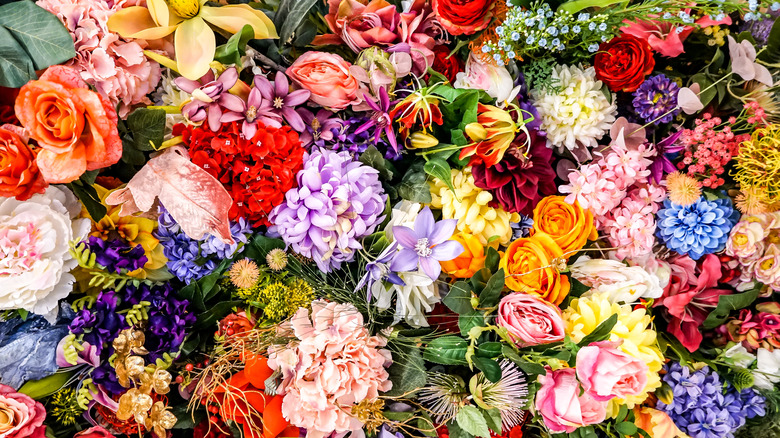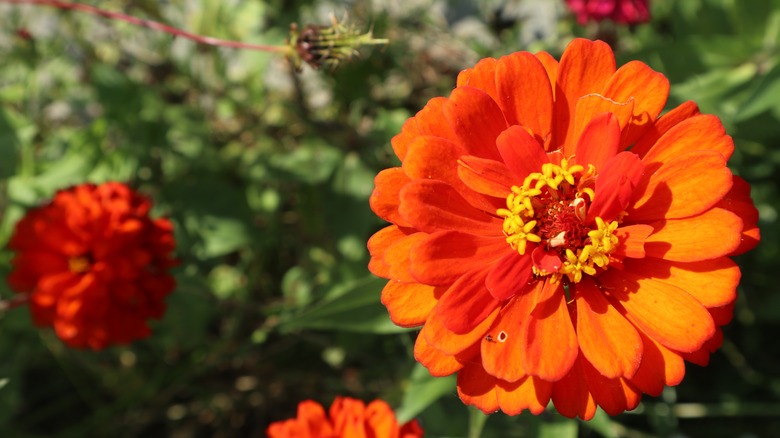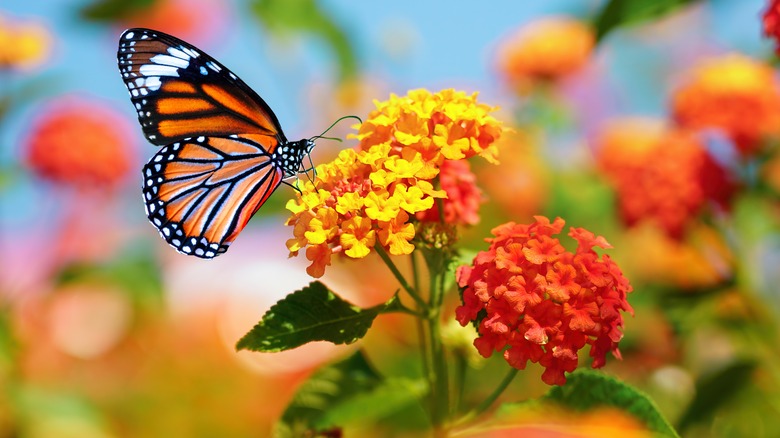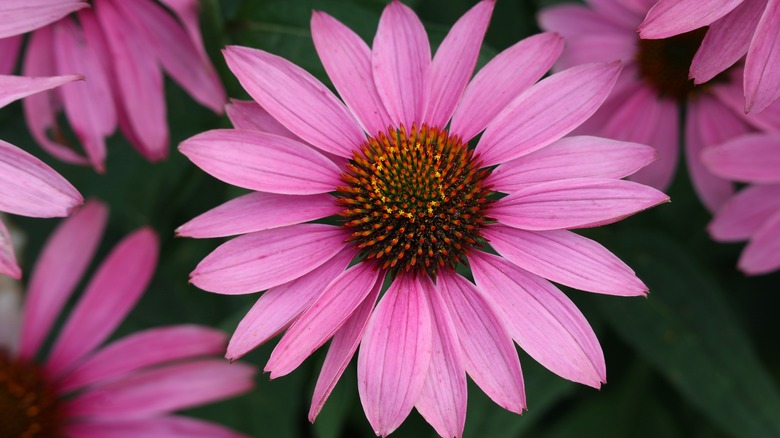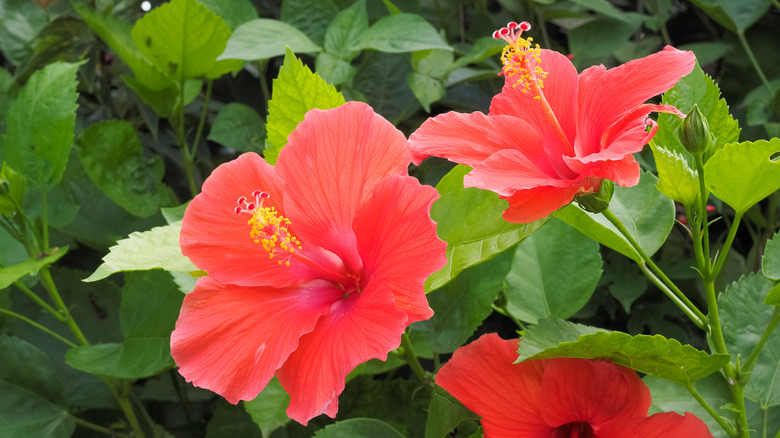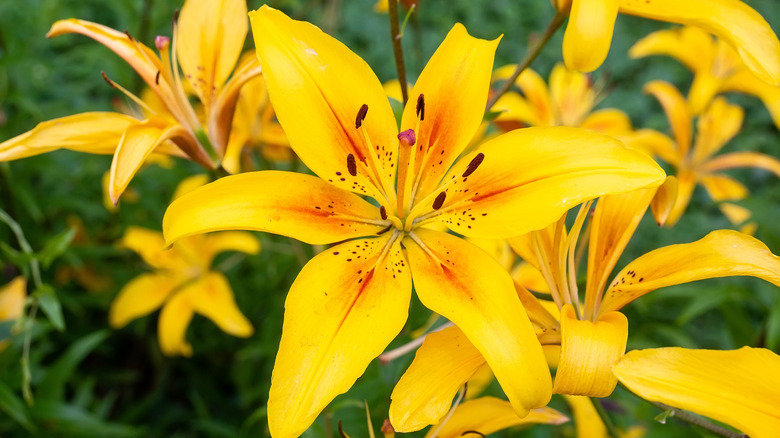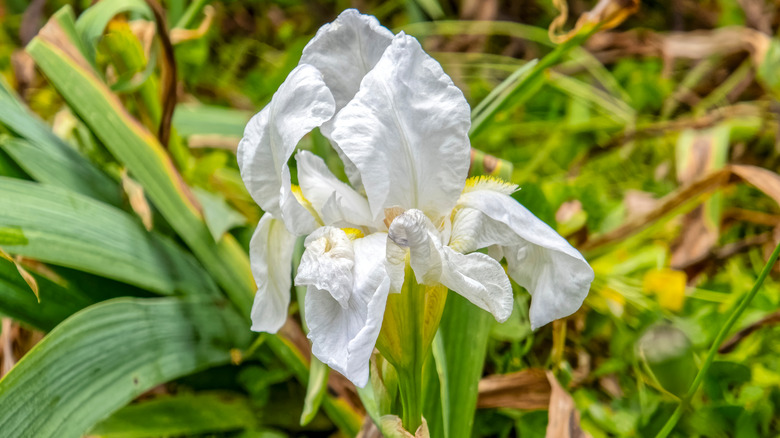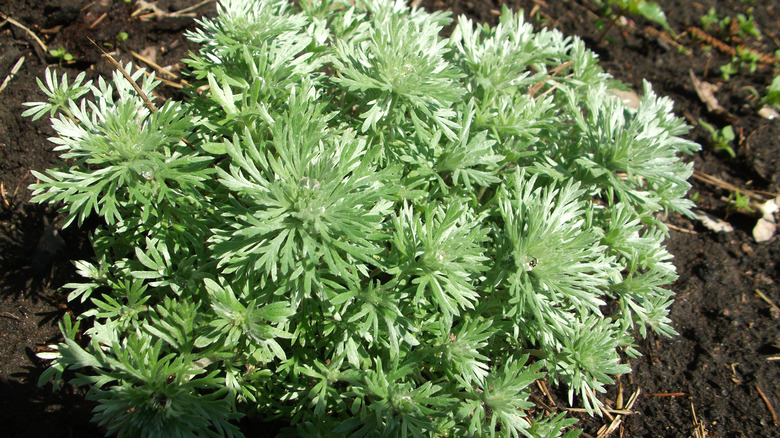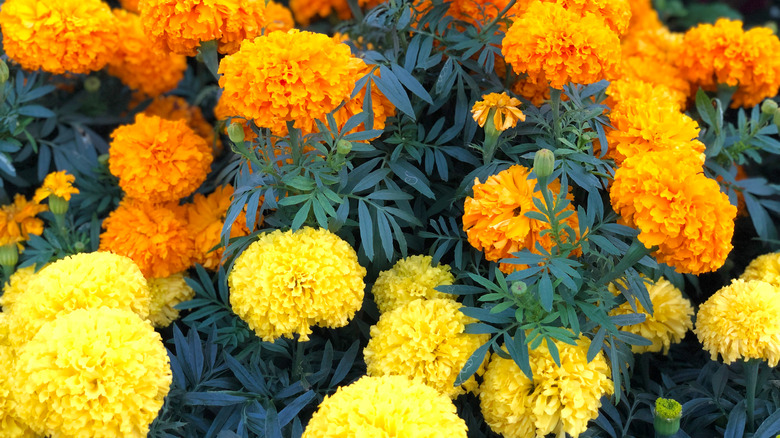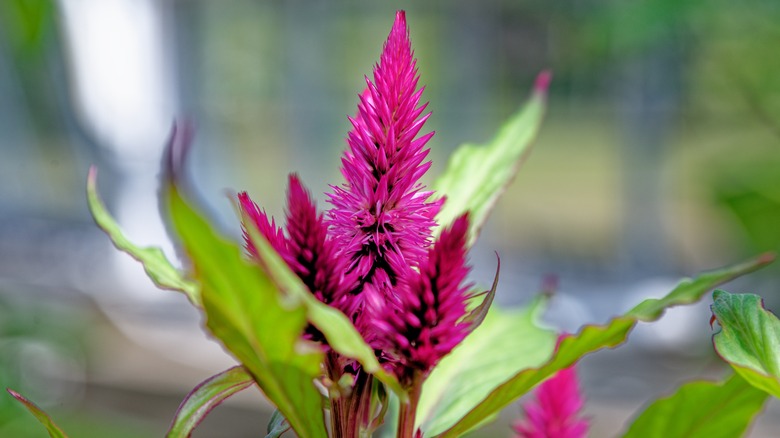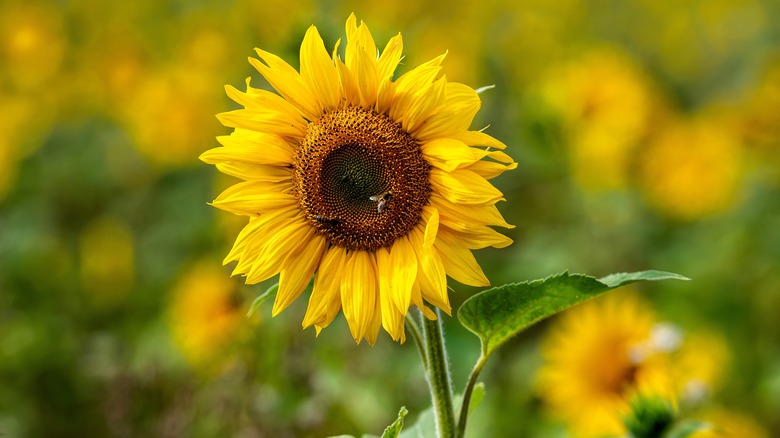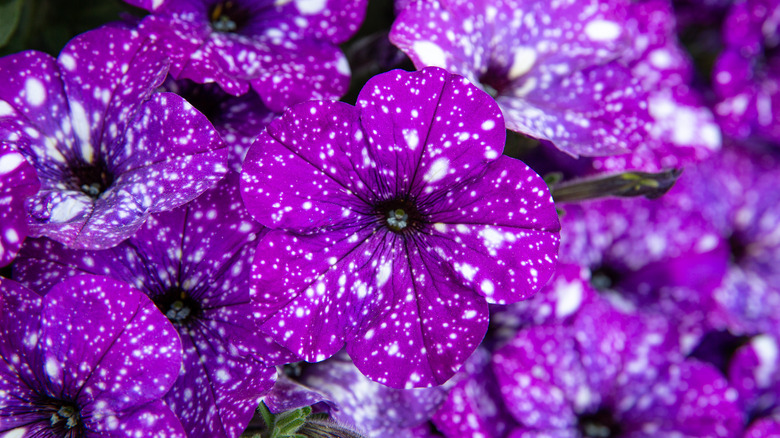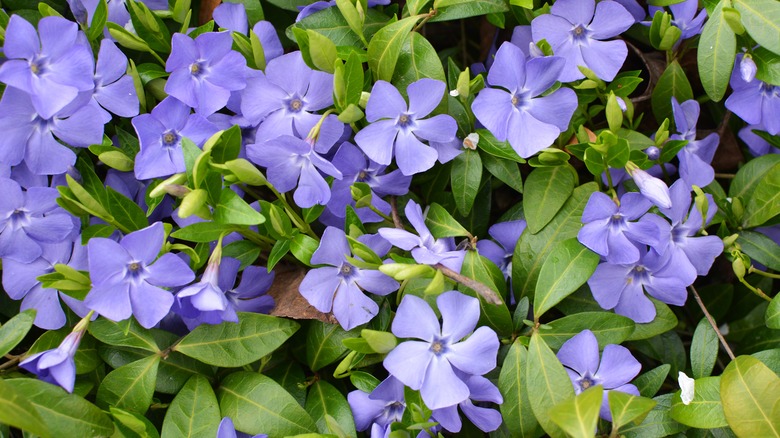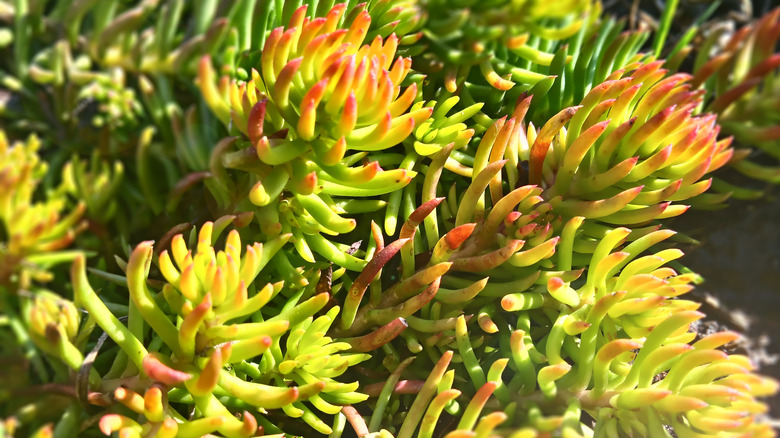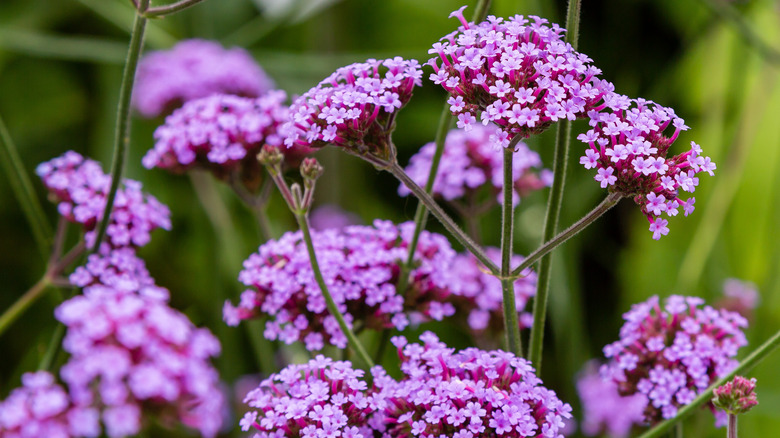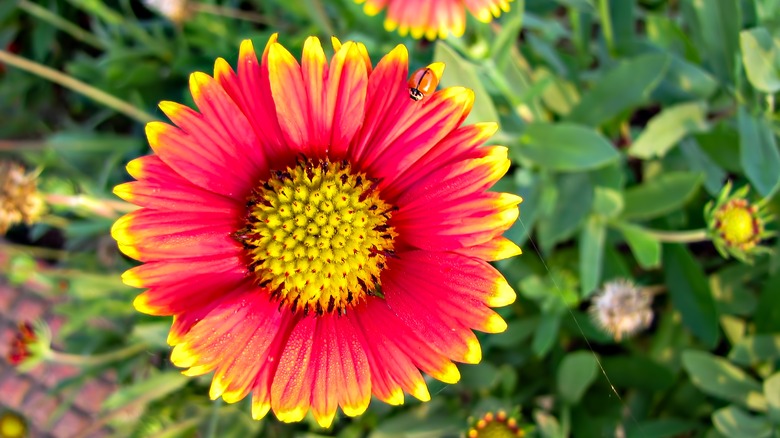15 Garden Plants That Will Survive Summers That Are Getting Hotter And Hotter
Is it just us, or does it seem to be getting hotter and hotter out there? Our yards desperately need heat-tolerant beauties to brighten our spirits and help us get through yet another hot day toiling in the garden. The good news is that there are many flowering garden plants that adore six or more hours of direct sun exposure every day, and they can even stand up to oppressive mid-summer temperatures without wilting or giving up, per Proven Winners.
From sprawling ground coverers and towering bloomers to annuals and perennials, we've compiled a list of the best sun worshipers, super, pollinator attractors, and downright tough-as-nails plants that will thrive throughout the sizzling heat of the day. Come along for the lowdown on spectacular garden plants to have your brightest, most flowered-filled summer yet. We'll cover the best planting locations for each species, offer simple plant care tips, and help you keep them alive!
1. Zinnias
Not only can zinnias (Zinnia sp.) take the heat like a champ, they actually love it. That might be because they're originally from Mexico. Per the IFAS Gardening Solutions at the University of Florida, the most common variety is Zinnia elegans, but many species are available. Known for their full range of vibrant colors, you can use versatile zinnias just about anywhere.
Bloom Season: Late spring, summer, and early fall
USDA Growing Zone: 9 to 11
Growing Conditions: Full sun
Soil Type: Well-draining
Size: 6 inches dwarf varieties to 3 feet tall
2. Lantanas
For a vivid splash of color that is sure to attract butterflies and hummingbirds to your yard, you can't go wrong with lantanas (Lantana camara). Dig, Plant, Water, Repeat explains that these dependable, drought-tolerant plants are guaranteed to thrive as the heat goes up. Left to grow, lantanas will become large bushes great for creating privacy.
Bloom Season: Spring, summer, and fall
USDA Growing Zone: 9 to 11
Growing Conditions: Full sun
Soil Type: Clay, loam, sand
Size: 2 to 6 feet tall and 3 to 10 feet wide
3. Coneflowers
Echinacea purpurea, commonly known as the coneflower, has a four-hour minimum for direct sun exposure and prefers even more. According to American Meadows, full sun is the way to go with these well-loved pollinators attracting flowers. They also create a sense of texture with the spiny seedheads in each bloom's center.
Bloom Season: Summer and early fall
USDA Growing Zone: 4 to 9
Growing Conditions: Full sun or partial sun
Soil Type: Well-draining soil, tolerant to nutrient-deficient or even rocky areas
Size: 3 to 4 feet tall
4. Hibiscus
It should come as no surprise that tropical plants fare well in hot climates, and hibiscus (Hibiscus sp.) will thrive in temperatures as high as the 90s Fahrenheit. However, as the American Hibiscus Society explains, their growth and ability to flower may stagnate once temperatures soar into the hundreds. Moving your plant into the shade and thoroughly watering it midday is all it takes to keep this one happy.
Bloom Season: Summer
USDA Growing Zone: 10 to 12
Growing Conditions: Full sun
Soil Type: Nutrient-dense with fertilizer
Size: 3 to 15 feet tall, 2 to 5 feet wide
5. Daylilies
It is impossible to go wrong with daylilies (Hemerocallis sp.). These tall, bright, big, and beautiful plants are known to flourish in areas as hot as southeastern Texas. In fact, per The Old Farmer's Almanac, these guys can handle just about any environmental situation. Thousands of daylily species offer you the ability to plant varieties that bloom at different times next to each other for a garden that never stops blooming from spring through fall.
Bloom Season: Spring, summer, and fall
USDA Growing Zone: 4 to 9
Growing Conditions: Full sun
Soil Type: Moist, well-draining soil
Size: 8 inches to 5 feet tall, 2 to 8-inch blooms
6. Bearded iris
Bearded irises (Iris × germanica) love a full day in the sun, but too much heat may cause them to lose some of their vibrant colors. A little bit of shade can fix that problem in a jiffy. The Clemson Cooperative Extension Home & Garden Information Center recommends the Iris albicans 'White Flag' variety (pictured above) for its ability to hold up in extreme heat.
Bloom Season: Spring and summer
USDA Growing Zone: 3 to 10
Growing Conditions: Full sun
Soil Type: Well-draining, slightly alkaline
Size: From 6-inch dwarf varieties up to 3 feet tall
7. Silver mound
Try the silver mound (Artemisia schmidtiana) for a low-lying plant to fill the space between taller flowers. Silver mound works well as a border plant with soft, almost feathery leaves that shimmer in a greenish-silvery hue, per Leafy Place. Mound, in its common name, refers to the shape it grows into at ground level. These plants will flower in early summer, but the tiny yellow blossoms will initially be unimpressive.
Bloom Season: Summer
USDA Growing Zone: 4 to 8
Growing Conditions: Full sun
Soil Type: Dry, moderately fertile; tolerant to almost anything
Size: 3 to 6 inches tall, 12 inches wide
8. Marigolds
If you're a beginner, marigolds (Tagetes) should definitely be high on your list. Cheerful, bright, and just about the easiest thing to grow, marigolds will take as much sun and heat as you can give them. Burpee says the worse the soil quality, the better these perky oddballs look. And they're edible too! All you really have to do is keep them well-watered.
Bloom Season: Early summer through fall
USDA Growing Zone: 2 to 11
Growing Conditions: Full sun
Soil Type: Well-draining, tolerant to almost anything
Size: 6 inches to 3 feet tall
9. Celosias
From the amaranth family, celosias (Celosia sp.) can offer up a brilliant shock of pink for the garden, but they also come in an array of warm-toned reds and oranges. These are fitting shades for a flower that requires at least eight hours of sun per day and whose name translates to burning in Greek, via the University of Minnesota Extension. The unique shape of this flower earned it the nickname cockscomb.
Bloom Season: Summer and fall
USDA Growing Zone: 9 to 12
Growing Conditions: Full sun
Soil Type: Well-draining, sandy
Size: From 6-inch dwarf varieties up to 3 feet tall
10. Sunflowers
Of course, Helianthus annuus, known as sunflowers, are on our list of sun-worshipping, heat-tolerant stunners. The stalks of these proud plants can grow to tower heights as they stretch towards the sky with their enormous blooms that can be as much as a foot in diameter. Gardenia notes that sunflowers are great for bees and feed many bird species with their seeds. Grow them wherever you wish to put on a show!
Bloom Season: Summer
USDA Growing Zone: 2 to 11
Growing Conditions: Full sun
Soil Type: Humus-rich, well-draining, and moist
Size: 3 to 10 feet tall
11. Petunias
Another mounding plant, but this one with dazzling and colorful blooms, petunias (Petunia sp.) are a no-brainer regarding heat tolerance and pizazz. Thanks to cultivators at LSU AgCenter, new hybrids have developed everyday petunias into Supertunias that can thrive in hotter climates than ever before. Petunias come in just about every color possible, with striped, speckled, and multicolored options.
Bloom Season: Spring, summer, fall
USDA Growing Zone: 10 to 11
Growing Conditions: Full sun
Soil Type: Well-draining mixed with compost
Size: 6 to 12 inches tall, 2 to 3 feet wide
12. Periwinkles
Vinca plants, commonly called periwinkle or sometimes myrtle, offer evergreen foliage along with delicate flowers that are usually blue or purple and occasionally white. According to the Clemson Cooperative Extension Home & Garden Information Center, Vinca minor is an excellent choice for a ground cover plant, while vinca major will sprout up to 2 feet into the air.
Bloom Season: Spring and summer
USDA Growing Zone: 4 to 9
Growing Conditions: Shade, partial shade, partial sun, full sun
Soil Type: Moist, well-draining, high organic matter content
Size: 6 inches to 2 feet tall
13. Sedum
Sedum rupestre 'Angelina' of the stonecrop family absolutely kills in both rock gardens and flower beds. Tolerant to all degrees of disregard, they can thrive in either full sun or partial shade, but Gardenia explains that the amount of direct light they receive changes the color of their foliage from green to yellow to orange tinge.
Bloom Season: Summer
USDA Growing Zone: 6 to 9
Growing Conditions: Full sun, partial shade
Soil Type: Chalk, clay, loam, sand; tolerant to poor quality
Size: 4 to 6 inches tall, 18 to 24 inches wide
14. Verbena
The Verbenaceae family is home to beautiful verbena flowers (Verbena officinalis). From pink to lavender to blue and purple, verbenas attract every type of pollinator to the garden. Since ancient times, these flowers have been considered sacred, according to Integrated Pest Management at the University of Missouri. In traditional medicine, they are still used to combat ailments brought on by menstruation, menopause, and breastfeeding.
Bloom Season: Spring, summer, fall
USDA Growing Zone: 9 to 10
Growing Conditions: Full sun
Soil Type: Moist, well-draining
Size: 9 to 12 inches tall, 12 to 18 inches wide
15. Blanket flowers
Can you believe this head turner? Blanket flowers (Gaillardia sp.) originated in the dry, dusty prairies so that they could take the heat without complaint. Per Better Homes & Gardens, innovative hybrids bring more colors to this bold flower's palette while increasing its hardiness. Blanket flowers stun on their own or pair well with ornamental grasses.
Bloom Season: Summer and fall
USDA Growing Zone: 3 to 10
Growing Conditions: Full sun
Soil Type: Tolerant to dry, nutrient-deficient, or even rocky areas
Size: 1 to 3 feet tall, 1 to 2 feet wide
